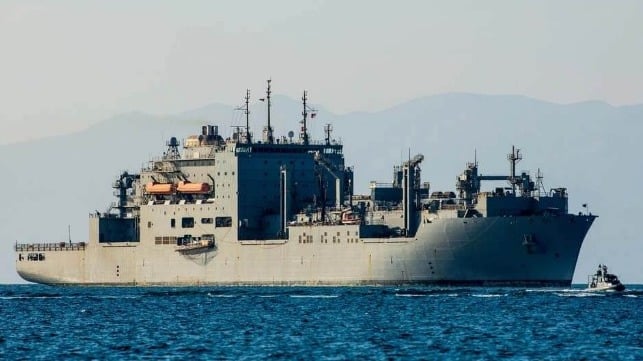Third Mate Ran MSC Auxiliary Aground When Captain Left for Meal Break

A master’s decision to leave the bridge of his ship while it was maneuvering and a failure to follow navigational procedures are being cited as contributing factors in a U.S. Navy investigation into the 2023 grounding of the supply ship USNS Alan Shepard. While the incident was only a minor embarrassment to the U.S. fleet, the report calls into question the decisions of the civilian officers manning the Military Sealift Command vessel.
The Alan Shepard (23,000 light displacement) has been in service supporting the U.S. Navy as a dry cargo and ammunition ship for fleet replenishment since 2007. The ship is 689 feet (210 meters) in length with a 30-foot (9-meter) draft. She is currently supporting the U.S. 5th Fleet in the Middle East.
The ship arrived in Bahrain in July 2023 for repairs. According to the report, on July 15 she was navigating from a shipyard to a berth in the Khalifa Bin Salman Port. She became stuck on the shoals in the port that afternoon and spent the night stranded. The following day, tugs were able to refloat the vessel on the high tide.
The investigation found that port authority instructed the ship to wait in a holding area in the port until a pilot could join the Alan Shepard. The pilot was going to guide the ship to the berth.
At 4:49 p.m. the master of the Alan Shepard along with the navigator and the chief mate reported that they were leaving the bridge for a meal break. Heading out for dinner, the master handed the vessel to the third officer instructing him to “stay the course and keep the ship in the waiting area.”
The junior officer on the bridge continued to navigate the ship but became distracted by harbor traffic. He turned the Alan Shepard to avoid a fishing boat in the harbor which caused the vessel to ground on the shoals. The master had been off the bridge for approximately 20 minutes according to the report.
The report highlights the ship’s standing order said the master was required to be on the bridge whenever they were navigating near shallow waters. The investigation cites the master for not following navigation procedures.
After the vessel was refloated, a survey was conducted that found the hull, propellers, and other underwater structures had avoided any damage. Mostly it was reported that the ship had some minor scrapes. None of the 85 crew aboard were injured in the grounding.
